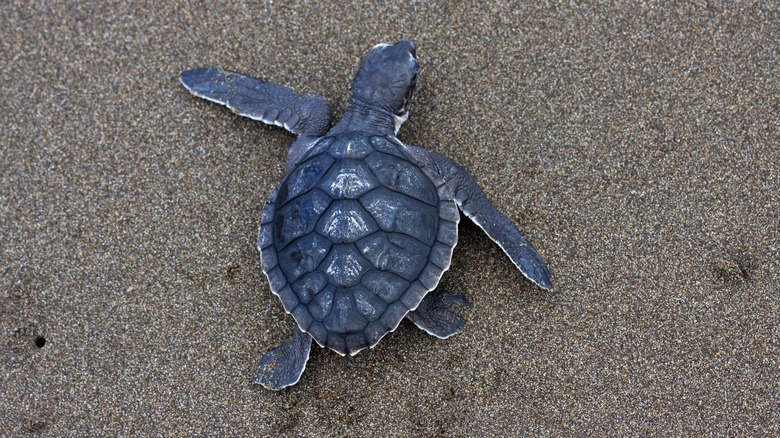The Unique Situation Many Sea Turtles Across The US East Coast Face
Sea turtles are among the few sea animals that humans occasionally have the opportunity to see both in the water and on land in the wild. Unfortunately, they're also among the ones that need rescuing at times. In the colder months, sea turtles can end up stranded on beaches, but not always from injury, illness, or low tides. Sometimes, the frigid water temperature in the fall and winter months causes these creatures to become cold-stunned until they end up washed ashore, in desperate need of help.
Sea turtles become cold-stunned when the water temperature drops to 50 degrees Fahrenheit, resulting in hypothermia. Not long after the exposure, they can become so weak and lethargic that they lose their ability to swim and begin to float at the surface. Depending on the tide and wind speed, they may remain on the surface, floating, or become stranded on a beach. In fact, dozens of them have wound up in the latter predicament on the beaches of Cape Cod in Massachusetts, Long Island in New York, and other areas that experience cold winters.
Unfortunately, there's no magic wand that we can dip in the oceans to make them warmer. There are, however, ways you can help a sea turtle that's stranded as a result of cold-stunning, should you ever encounter one while hiking with your dog along the beach.
How to help a cold-stunned, stranded sea turtle
In addition to Cape Cod and Long Island, cold-stunned sea turtles have been reported in Pamlico Sound, North Carolina; Mosquito Lagoon and St. Joseph Bay in Florida; and bays statewide in Texas. However, it can happen anywhere that the water dips below 50 degrees Fahrenheit. If you happen to be walking down the beach in the late fall or winter and come across a stranded sea turtle, your actions can save its life.
First, call your local stranding network, as you won't be able to give the turtle the care it needs on your own. Be prepared with location details and the turtle's status. Keep in mind that a cold-stunned sea turtle will need to be removed from its location by a professional wildlife rescuer and rehabilitated in a designated facility. These animals sometimes develop pneumonia, infections, and other conditions related to the cold water, so they require specialized veterinary treatment before they can be released back into the ocean.
The rehabilitation process could take months, partially because the rehabilitators sometimes have to wait for warmer weather, even if they opt to relocate the turtles to the south. With the rise of cold-stunning, staff and volunteers at wildlife sanctuaries take a proactive approach to rescue by monitoring the beaches during stranding season. If you live near a coastal area where cold-stunning could occur, contact your local wildlife sanctuary to see how you can help. Want to learn more about sea turtles? Check out the beautiful place in Malaysia where sea turtles might swim up to you.

